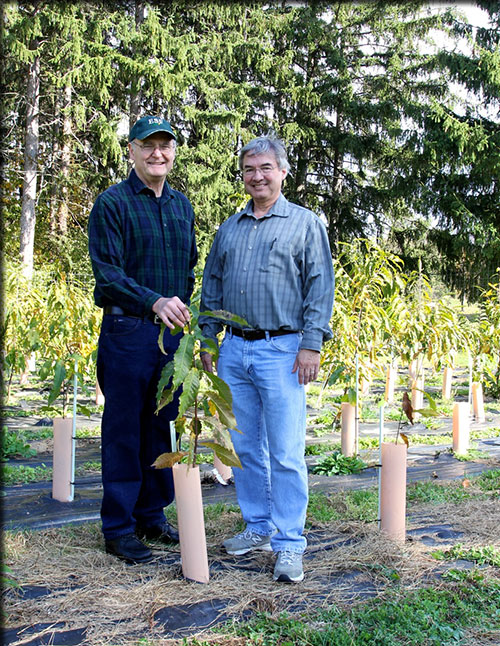Man, it would be awesome to have some chestnut trees
Scientists at the SUNY College of Environmental Science and Forestry (ESF) are growing the first American chestnut trees that can withstand the blight that virtually eliminated the once-dominant tree from the eastern United States.
Members of the ESF research team recently published three peer-reviewed papers that, along with continuing research, support their conviction that their biotechnology work with a gene originating in wheat makes the American chestnut tree at least as blight resistant as the Chinese chestnut tree that can co-exist with blight with minimal ill effects.
"Our goal was to develop an American chestnut tree that has blight resistance equal to that of a Chinese chestnut and we are there. We've done it," said Dr. William Powell, an ESF professor who leads the research project along with Dr. Chuck Maynard. "The leaf assays show it, the small-stem assays show it," Powell said, referring to the analytical processes the researchers go through to determine the level of blight resistance. "These American chestnut trees are blight resistant."
"It is tremendously satisfying to reach this level of success. We have a lot of people to thank for this. It's been a long haul but we are happy with where we are," Maynard said. A significant milestone in the process, he said, was reached when the transgenic trees, inoculated with the blight during testing, remained essentially as healthy as control trees that had been inoculated with only water.
The tree was once prominent enough to have earned a place in American culture, with chestnuts roasting over open fires in the winter, and Chestnut Streets running through towns across the country. The wood of American chestnuts is rot-resistant, making it suitable for construction purposes, and its abundant nuts were once a dietary staple for wildlife.

The next step in its return is for the researchers to select one of the 14 lines of transgenic trees with blight resistance and submit a detailed application to the federal agencies that will conduct a rigorous review process. The U.S. Department of Agriculture, Environmental Protection Agency, and Food and Drug Administration must approve the trees before they are available to the public for planting. If all goes well, the process could take around five years.
This is the first time the approval process will be used for a tree that is ultimately destined to be planted in the wild. The process has been applied to many crops, orchard and plantation trees, but not to species that are native to U.S. forests.
In the meantime, Powell, a molecular plant biologist, and Maynard, a tree improvement specialist, will produce as many trees as possible, perhaps 10,000, so they are ready for planting if and when the approval process is complete. The ESF College Foundation, Inc., which supports the college's educational mission, continues fundraising efforts to support the work.
"The team has accomplished a major goal, the generation of a blight-resistant American chestnut tree," said Dr. Timothy Tschaplinski, a scientist at Oak Ridge National Laboratory who does chemical analysis for the research team to determine if the tissue of transgenic trees differs from that of wild-type trees. "The results of the metabolite analyses indicate that the nuts produced from transgenic plants aren't appreciably different from those produced by wild-type plants and should be safe for consumption. The sum total of these efforts is a major step forward for the goal of restoration of American chestnut to the North American landscape."
Continuing research by ESF and collaborators from other institutions indicates that the transgenic trees do not affect the composition of leaf litter, the feeding habits of insects or the growth of ecologically important fungi.
Most Users Ever Online: 698
Currently Online:
53 Guest(s)
Currently Browsing this Page:
1 Guest(s)
Top Posters:
easytapper: 2149
DangerDuke: 2030
groinkick: 1667
PorkChopsMmm: 1515
Gravel Road: 1455
Newest Members:
Forum Stats:
Groups: 1
Forums: 12
Topics: 11482
Posts: 58640
Member Stats:
Guest Posters: 2
Members: 19842
Moderators: 0
Admins: 1
Administrators: K

 Log In
Log In Home
Home
 Offline
Offline






